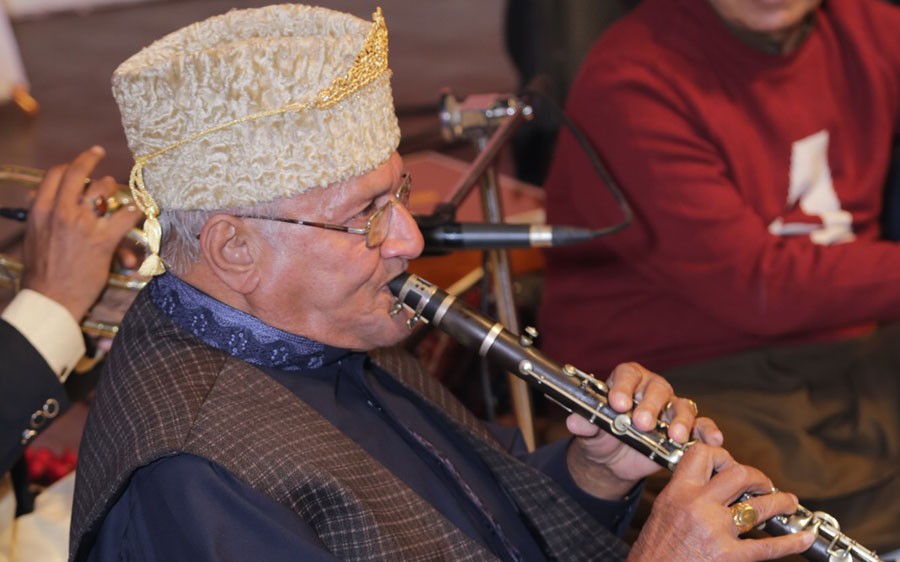
The legendary Ustad Sadiq Hussain was crowned by Caravan at Alhamra in Lahore recently

It is the usual practice with musicians, especially of the classical variety, that no matter what the occasion is, it has to be paid homage to or celebrated with music.
So when Usad Sadiq Hussain was being crowned at the Alhamra recently by Caravan, it was accompanied by music.
Akmal Qadri played the bansuri while Chand Khan and Suraj Khan sang to pay their compliments to the Ustad. The Ustad also played the clarinet so as to be appreciative of the organisers and the audiences for their willful acceptance and participation.
Ustad Fateh Ali Khan popularly known by the suffix Hyderabadi also paid compliments to Ustad Sadiq Hussain.
Ustad Sadiq Hussain is the shagird of Alamgir Khan, and hence belongs to the Gwalior gharana. His short piece at the coronation was enough to demonstrate his command over the sur and the systematic expansion of the raag which is only learnt if formally instructed in music by an ustad. Clarinet is a western instrument supposed to play the staccato note.
It was thought that it did not have the capacity to incorporate the microtones, which is the very essence of our music. But, in the hands of many of our masters, these instruments were played very differently, and almost sounded like our very own.
Many other western instruments too have been modified in the same manner. They appear to be our own. The list is long and impressive beginning with the harmonium which has disappeared from the western orchestras but finds a permanent place in our music. Violin, piano and even the guitar are played with the desire to do away with the rigidity of the staccato note.
Clarinet’s staccato note was mixed with the delight of meends, the glides and the playing of the microtones. The instrument could be played solo with the exploration of the raag and it came out of the shadow of merely being an instrument that formed part of an orchestra.
In the Punjab, Ustads Alamgir, Shahjahan and Jahangir were also great clarinet players. They had formed a band. Since clarinet was an essential instrument of a brass band they started to play raags on them instead of western compositions. These brass bands were usually engaged on marriage ceremonies, and Jahangir, Alamgir and Shahjahan, alongwith another brass band led by Master Sohni, were the two leading group of exponents of the instrument.
Clarinet came to the subcontinent through the various brass bands that were introduced by the likes of the army, police, and rangers, primarily for parades. Gradually, some of the western tunes or compositions were played by these bands as they also performed in the evenings at various clubs dominated by the colonialists. But since most of the musicians were hereditary, it was only a matter of time before indigenous compositions and tunes too started being played on the instrument. As brass bands were also used for marriage ceremonies, the local bands were formed to do exactly that. But local compositions were played.
Clarinet led the melodic line and it was accompanied by percussion instruments.
Ustad Alamgir Khan learnt to play the local compositions from Ustad Bhai Lal Muhammed and honed them. It was only a matter of time before he formed his own band. The band was not only accompanying fixed compositions enhancing the mood of merriment but emerged as serious practitioners of raagdari. Some later progeny also chose the shehnai -- and Rangi Khan (Aurangzeb Khan) became an outstanding exponent of that in Pakistan.
Caravan was formed some years back by a group of dedicated individuals - foremost among them being Afaq Hussain - for the cause of classical musical forms in the country. It has been holding music programmes and honouring musicians, especially of the classical ilk by holding "taj poshi" ceremonies. It is a kind of a continuation of our traditional style when the "taj" symbolised the ruler or the highest office in the country or an epitome of something. Anyone adorned with such a gesture would be considered a king or a queen or the best in that profession or craft.
This was the fifth coronation to be held under the auspices of Caravan, and before this, coronations of Ustad Ghulam Hassan Shaggan in 1993, Mehdi Hassan in 1996, Ustad Salamat Ali Khan in 1998 and Ustad Abdus Sattar Tari Khan had been much celebrated.
As can be seen from the list, Caravan has always chosen the very best for this ceremony so no one can say that there has been a compromise in the choice of those crowned.
The presence of Ustad Fateh Ali Khan Hyderabadi was particularly poignant because he can now be called the representative figure of the Gwalior gaiki in the country. Originally from Amritsar, the family traces its ancestry to Ustad Banne Khan, who became the shagird of Ustad Haddo Khan in Gwalior and introduced that gaiki to Punjab in the 19th century. One branch of his progeny settled in Sindh. They are thus called Hyderabadi, to distinguish them from their namesake-cousins from the Patiala gharana.